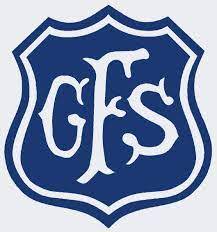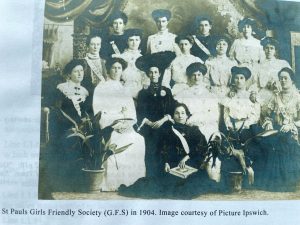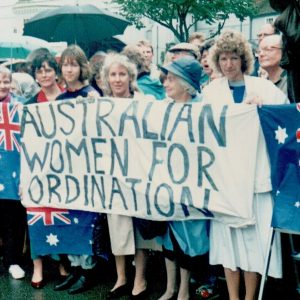
The Mothers’ Union, Brisbane (1904-)
To win the homes of the nation for Christ
Click for More
An enduring organisation, the Brisbane branch of Mothers’ Union was formed in 1904. Since then it has evolved from the goal of organising a band of Mothers united in prayer and seeking purity and holiness of life. Nowadays, the emphasis is still on family and is expressed through several development projects worldwide.
The early days
It is a call to every one of us to live in prayer that His help, His blessings, and His inspiration may rest upon our earnest efforts.
These are the words of Mary Sumner, the foundress (sic) of The Mothers’ Union in England, in 1876.
This was an era when the British Empire was a very strong force in the world, with widespread territories and colonies. It is not surprising that by 1892, MU arising out of the Church of England, had spread to many countries including Australia.
In 1903 the Church Chronicle described the aims of the Mothers’ Union: to uphold the sanctity of marriage; to awaken in Mothers their sense of responsibility in the training of boys and girls; and to organise in every place a band of Mothers who will unite in prayer and seek, by example, purity and holiness of life.
The first MU branch in Australia was formed in Tasmania in 1894. In Brisbane, the vision of Mrs Elizabeth Exley saw the formation of a parochial branch at Christ Church, Milton in 1904. Mrs Exley, with the support of MU was a driving force behind the 1937 establishment of MU District Nursing Association (became St Luke’s Nursing Service in 1968).
In 1906 the Governor’s wife, Lady Chelmsford became MU President and in 1909 MU was constituted as a Diocesan organisation.
Through succeeding years, membership flourished. Underpinned by prayer and Bible study, MU run programs for mothers and children, providing support through both World Wars. MU’s departments focus across many areas: Prayer and Spirituality; Lone Members; Publications; Promotion and Development; Education; Social Issues and Action; Overseas and Northern Outreach and Links; Magazines/ Mia Mia editor.
Societal changes in the 1960s and 70’s such as the use of contraception and divorce caused MU to reassess its position. Rigid membership rules were changed to include all those who have been baptised in the name of the Holy Trinity and declare their support for the Aims and Objects of the Society.
Young members’ department
This less structured organisation commenced in 1949, to assist young women to grow in their Christian life and join MU in the future. Meetings were less formal, engendering fellowship and fun, as well as social work and Bible study. In 1983, this organisation was renamed Caritas, membership rules and age limits were removed. The organisation disbanded in 2016.
Autonomy of Anglican Mothers’ Union Australia
In 1974 autonomy was granted to the Australian Commonwealth Council of The Mothers’ Union, by the English Central Council. A new Royal Charter was granted by Queen Elizabeth II in which the Aim and Objectives were reworded to those in use today.
For Brisbane Diocesan MU, the most outstanding event was hosting the first World Conference to be held in Australia in 1979. This conference marked the true nature of MU’s worldwide partnership. More recently, in 2008 Brisbane MU hosted the Special World Wide Regional Meeting in Toowoomba.
Renamed Anglican Mother’s Union of Australia in 2016, AMUA continues its focus on family life, advocating for such issues as domestic violence, child abuse, migrants and gambling. Positive parenting programs continue across Australia and around the world. During 2020-2021 AMUA is raising money to support a locally adapted Positive Parenting program in Papua New Guinea. Contributions to the Overseas Fund support many projects addressing literacy, gender equity and gender based violence. MU members in Solomon Islands are part of a taskforce to improve community-based outcomes for women in remote communities with respect to gender equity and gender justice. Each year AMUA participates in 16 Days of Action Against Gender-based violence.
In later years, AMUA has diminished slightly in numbers, with its membership representing an older age group of women and some men.

Girl’s Friendly Society
There is always a deep interest in looking back to the beginnings of a great movement – in recalling the sowing of the first tiny seed that contained within it the germ of a living and growing tree, and GFS has been a growing tree within this diocese for 135 years.
In 1874 there was limited education, and little chance of technical training for girls. For most there was only domestic or factory work, and in these areas the wages were low, hours long, and conditions sub-standard. In May 1874 a meeting was held at Lambeth Palace to discuss her ideaS, so GFS – The Girls Friendly Society – was born.
Inspired by her own deep faith Mary’s list of achievements is impressive. She cared for the whole person of her girls and was constantly expanding the departments of GFS to meet their needs. She recruited ‘Mother figures’ to whom the girls could turn to for advice and friendship and opened hostels where the girls could live reasonably and respectably
In 1879, only four years after the commencement of GFS in England, the wife of the Governor of South Australia, Mrs Jervois held the first meeting of GFS in Australia.
In Queensland it was the energetic zeal of Mrs Glennie and Archdeacon Glennie that started GFS in Brisbane. The first meeting was held in October 1882,
For the first few years the aim of GFS in Australia was to help girls who had emigrated from the homeland, most of whom obtained positions in domestic service. But, as time went on the scope of the society widened, with the expanding opportunities for women’s work in all directions. Workhouse girls, shop girls, factory girls, and the emerging class of business girls were all encouraged to join GFS and extend the hand of friendship to each other. In brief GFS had become a universal society of the Anglican Church, among women and girls from all walks of life.
As the society’s work in the early days was mainly in meeting immigrants from England it was deemed necessary to have a lodge to house them, and the first of these was opened in Spring Hill. With a bequest in 1921 a ‘Hostel Fund’ was established, supplemented by fund raising. In 1942 it was decided to purchase a home in New Farm, and convert it into a hostel, instead of building a new one. This was named ‘GFS House’.
From 1942 – 1946 GFS House was used to house service women. In 1946 it began operation as a hostel for country girls attending schools and colleges in Brisbane, and so it continued to offer accommodation to single young women until the 70’s. The changing life styles of the 70’s saw the dormitory accommodation that the hostel offered as being unacceptable to the modern girl. Financially it was not viable for GFS to keep it running, so in 1976 the Brisbane Anglican Diocesan Council was given the use of the property for social work amongst women. It was used by Anglicare for many years as a Women’s Hostel. GFS House was sold in 2009. From sale of the property, GFS donated over $2 million to Anglicare towards their ‘Home Away from Homelessness’ facility that has since been built at Toowong.
There are not many parishes in the Brisbane Diocese that have not had a GFS branch over the years. The post war years saw a great upsurge in numbers, and at its peak in the early 60’s there were nearly 100 branches with a membership of 2340. Since then membership numbers have decreased significantly due to changes in the style of Children’s and Youth Ministry and lack of leaders. There are few remaining branches in the Diocese, engaging in the traditional activities of Christian teaching, craft and games, formerly engaged in by GFS.
GFS still retains Mary’s vision, and has moved forward with its network of support and resources, reaching out with many forms of ministry. Over $3 million was invested after the sale of GFS House and the interest is used to support parishes and agencies in the diocese with grants for their own Children’s and Youth Ministry. GFS supports the Ministry Education Commission. Two Bursaries are given each year to students at St. Francis Theological College. GFS also funds a Chaplain at the Queensland Children’s Hospital. A Diocesan Project is supported each year, as well as financial assistance to the GFS World Body. Although GFS does not have many of its own branches, Children’s and Youth Ministry is still supported in the Diocese. GFS is very happy and proud to be able to support parishes and agencies in that ministry.

Acknowledgement: Lesley Briggs, Margaret Humphries

The Movement for the Ordination of Women
A landmark social change
One of the most successful advocacy efforts on behalf of women in the 20th century was the Movement for the Ordination of Women (MOW) through the 1980s and 1990s. Its aim of the priesting of women was achieved in 1992. Since then women have gone on to become bishops and archbishops. However, the struggle is not over in some dioceses, notably Sydney.
Click for More
Maude Royden, suffragist and first proponent of women’s ordination in the Church of England visited Australia in 1928, including a trip to Brisbane. Here she was welcomed by prominent dignitaries, including staying at the Governor’s residence. She preached at Albert St Methodist Church but was not welcomed by the local Church of England.
Brisbane MOW is born, 1984
A long gap ensued before Brisbane women banded together to advocate for women’s ordination in the Anglican Church of Australia. Unlike Sydney, Melbourne and Adelaide Dioceses, there was no prior activist group of women focussing on women’s priesting in Brisbane. The first meeting of Brisbane women was initiated by Gwenneth Roberts who had met with Dr Patricia Brennan, founder of the Movement for the Ordination of Women (MOW) in Sydney. Gwenneth was greatly inspired by Patricia Brennan to initiate MOW Brisbane with Marian Free.
This first meeting of Brisbane MOW was held at the Augustinian Priory, Clayfield in April 1984. The guest presenter was Monica Furlong, Moderator of English MOW, who described the tired Anglican Church as a “croquet lawn” with the women’s movement “like a great spring of water gushing up in the middle of the lawn”. Women came together, a disparate group, from different backgrounds and churchmanship, mostly active in their Parishes. They shared their call to ordained ministry, talked a lot, wept and raged. Joan Lethlean said “…under Monica’s quiet leadership great healing took place that weekend”. Many of the women present went on to make significant contributions to the movement, such as Mavis Rose, Gwenneth Roberts [link], Marian Free and Philippa Wetherell.
Although not an official body of the Anglican Church, MOW Brisbane was officially launched on October 6, 1984 at St Francis’ Theological College; Principal Canon James Warner was a great supporter of women’s ordination. Supportive men such as Mervyn Lander, John Roberts, Kevin Lethlean and others were members of the group. Women from other denominations – Catholic, Uniting Church, Lutheran and others – became members.
The work of MOW
The task of MOW was focussed – to persuade members of the local Brisbane Synod and the General (National) Synod to pass legislation to enable women to be deacons, priests and bishops. It pursued its campaign with vigorous advocacy – Synod members speaking to motions for women’s ordination, communicating with Bishops and Clergy who supported women’s ordination, protest banners displayed outside Cathedral and Churches, letters to the Editor of local and national Anglican newspapers, representation at MOW National meetings, attendance at National Conferences, and a presence at General Synods in Sydney.
The 1992 conference
A landmark National MOW Conference was held at Halse Lodge, Noosa, combined with a women’s Art Exhibition, in 1992. Dame Quentin Bryce, then Federal Sex Discrimination Commissioner, opened the Exhibition. She wept as she noted the failure of the recent General Synod to pass enabling legislation for women priests by one vote in the House of Clergy.
Opposition
MOW experienced some strong opposition in Brisbane with the formation of the Campaign for the Historical Male Priesthood (CHAMP). MOW was task oriented, expending much of its energies in conflict. Their lack of pastoral care resulted at times in internal disagreements on strategies, and moments of despair, part of the price of the struggle. Internally, members wrote liturgies and prayers, studied feminist theology, had fun engaging in performances of creative satire, and sang inclusive language hymns.
MOW disbands
MOW Brisbane disbanded in 1997, following the ordination of women as Deacons in 1988 and Priests in 1992. At an evening of reunion and celebration the high and low spots were remembered; but they had all been enriched by their experiences and strong friendships forged as they challenged the Anglican Church to respond to the world wide movement of the Spirit that allowed women to follow their calling.
In the words of Patricia Brennan, “We few, we happy few, we band of sisters (and the odd brother) we will remember while others forget, that we gave everything we had to give, once in our lives, for justice!”
MOWatch forms
A few years after many setbacks and achievements culminated in the ordination of women to the priesthood MOW was described as ‘one of Australia’s most forceful reform movements.’
Women campaigning for priesthood and for visible participation in the church’s life, liturgy and leadership was as much a novelty in the Diocese of Brisbane as elsewhere. Some diocesan leaders were supportive – to varying degrees – while others condemned MOW as no more than secular feminists who had turned their attention to the church.
Click here to View the MOW Page
Contains Biographies and videos of many of the key advocates
MOWatch – Into the Future…
In 1995 National MOW hosted a conference in Sydney for ordained women. Titled Astonishing Women the principal speaker was Bishop Penny Jamieson from New Zealand.
Click for More
This was a time of adjustment for National MOW and branches. The long hard road for the ordination of women enabled a breakthrough, but the task would not be over until all dioceses in Australia accepted women to be ordained. Later that year, the National body revised the way forward and a new constitution was accepted. MOW became MOWatch; the name was the suggestion of Alison Gent a dedicated member from Adelaide who considered this to reflect the ongoing work of MOW and the need to ‘watch’ what was happing for ordained women. The struggle continues, particularly in the diocese of Sydney where the determination to overcome the refusal to accept women as priest or bishop is maintained.
From 1997 there was a lot of work to do and residential conferences held every two years was a wise decision. MOWatch also decided to invite different dioceses to host the occasion. This enabled local people to plan and provide for attendees to experience various perspectives of women’s ministry across the country. After Brisbane, host dioceses included Adelaide, Alice Springs (diocese of the Northern Territory), Perth and Kincumber in (diocese of Newcastle). Individual branches also held various conferences, including the celebration of significant milestones in many areas of ministry.
With the help of generous donations, we were also able to invite overseas speakers to these conferences. Many visiting for the first time; Jane Shaw, and Paula Gooder each came on two occasions, Esther Mombo from Kenya, Jenny Plane Te Paa from New Zealand and Kay Goldsworthy who was to be consecrated bishop (and Archbishop) in Australia. Perhaps the most exciting outcome of these events, was the opportunity to hear from Australian women travelling alongside MOWatch, in particular those writing books from various perspectives of the Church.
The dedication of our Movement to continue the aim for every diocese to admit women to the three-fold order remains strong. From the new Anglican year book for Australia we will soon provide the present statistics for women clergy across the country on our website. There is also a page related to MOW in the year book and a photo that is a ‘first’ for this publication. Do take a look and follow us on Facebook.
In the process of updating our Constitution, we have changed MOWatch back to MOW, but kept our domain as http://mowatch.com.au As we remember the past we look to the future as we plan to celebrate 30 years of the ordination of women to the priesthood in Australia in 2022.
Val Graydon
Read further on the journey of Women’s History in the Church
You are on Page 2: Women’s Organisations
1 Women in Brisbane Diocese 3 Early Women’s Missionaries 4 Emerging Leaders
5 MOW 6 Ordination Achieved 7 The Way Forward